The Society of the Masks :
Masked dance
performances are held on the occasion of funerary rituals (Dama &
funerals). These rituals are governed
by the Society of the Masks. This society gathers all circumcised men,
young and old. Young boys become members after having been circumcised.
Authority is established according to age. Many members sculpt their
own mask.
Before, in mythical
times, death did not exist. Instead, men metamorphosed into serpents.
Yet, after the breaking of a taboo, the Dogon were exposed to death.
The Society of the Masks celebrates the cult of the first ancestor who
died in the form of a serpent after having transgressed a taboo. Ever
since that time, death has been transmitted to men through contagion
(not to be confounded with the ancestor Lebe Seru who resurrected and
who is immortal).
The Society of the
Masks is directed by the Wala Banga (chief of the mask altar).
Amadingue Dolo was the Wala Banga of Sangha. He made part of the informants
working for Marcel Griaule's team. Amadingue died in 1985. Ethnographic
literature refers to the Awa Society. According to Amadingue Dolo the
name Awa is wrong. The correct name is Jeme. In
Sigi So (the secret language of the Sigui) Awa means Kanaga.
|
 |
|
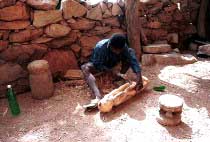 |
|
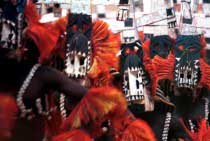 |
|
amadingue
dolo - wala banga
|
|
dancer
sculpting his own mask
|
|
kanaga
dancers
|
|
Funerary rites :
Funerary rites
consist of the burial, the funeral and the Dama.
The burial is held within a short
period of time following death. After having wrapped the deceased in
a mortuary blanket, the body is pulled up with ropes to the burial site
higher up in the cliff. The face of the cliff is strewn with caves of
which some serve as cemeteries. The blanket is recovered. Later during
the funeral it will play a central part in the Baga Bundo ritual. On
the plateau burial cave sites are located next to each village.
|
 |
|
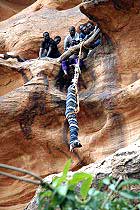 |
|
 |
|
yougo
dogorou
|
|
yougo
dogorou
|
|
cemetary
of yougo dogorou
|
|
The funeral
(Yimu Gono) is held a few days later or even several months after that
the body was lain to rest in the cemetery. The purpose of funerals consists
in restoring harmony between the world of the dead and living. The soul
of the deceased must be conducted to the hereafter.
The Dama
marks the end of mourning and the passage of the soul of the deceased
to the land of the ancestors. This ritual takes place around Mai/June.
There is a small and a big Dama. The small Dama is still regularly held.
It concerns one individual only. The big Dama concerns all villagers
who passed away since the previous big Dama. Many years may go by between
two Dama's; 10 to 12 years and even more (see page 15). Before, the
Dama entailed a human sacrifice. Today this practice has been abandoned.
The funeral (Yimu Gono) :
Most funerals are
held between December and February. The harvesting is over, the granaries
are full and the next sowing season will begin in a few months only.
Since there is no work in the fields, men and women may go about other
business. Time has come to organise funerals for those who passed away
in recent months. A funeral lasts two or three days. Many visitors will
come and offer condolences to the family of the deceased.
Dances and mock
battles (for example against the old Fulani enemy) are held day and
night. Close relatives and visitors mime battle scenes in the village
center, around the house and on the roof terrace of the deceased. They
fire blank shots with locally made flint rifles and fight with spears,
shields and lit torches. The noise is ear-splitting and the participants
are, from time to time, enveloped in a cloud of burned gunpowder. The
atmosphere is often festive.
|
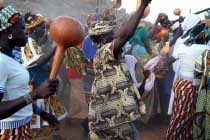 |
|
 |
|
 |
|
kundu
andou
|
|
yougo
dogorou
|
|
kundu
gina
|
| |
|
|
|
|
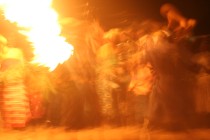 |
|
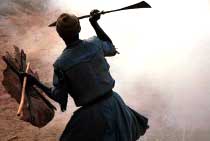 |
|
 |
|
kundu
andou
|
|
yougo
dogorou
|
|
kundu
andou
|
|
The more dramatically
powerful moments take place on the roof terrace of the deceased. Some
of his personal belongings are deposited there. In case he was an old
war veteran, a life-size dummy dressed in military uniform will be clearly
visible from all around.
|
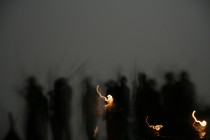 |
|
 |
|
 |
|
kundu
andou
|
|
kundu
andou
|
|
kundu
andou
|
| |
|
|
|
|
 |
|
 |
|
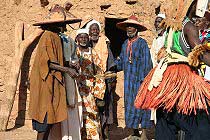 |
|
kundu
andou
|
|
kundu
andou
|
|
kundu
andou
|
|
Some dignitaries
and close parents climb on the roof and sacrifice a goat. Rituals vary
from village to village. In Kundu the goat is castrated before it is
killed and is then thrown from the roof onto the ground. In Yougo Dogorou
the animal is not castrated. Instead, after it has been killed, the
sacrificer will take off the hide and leave the carcass on the roof.
After the blood sacrifice it is the masked dancers' turn to mount on
the terrace and dance. The purpose of these ritual activities consists
in attracting the soul of the departed out of his house so that it may
commence its journey to the Hereafter.
|
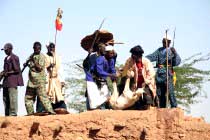 |
|
 |
|
 |
|
kundu
andou
|
|
yougo
dogorou
|
|
kundu
dogomo
|
| |
|
|
|
|
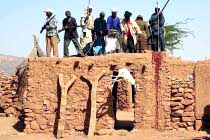 |
|
 |
|
 |
|
kundu
andou
|
|
yougo
dogorou
|
|
kundu
gina
|
| |
|
|
|
|
 |
|
 |
|
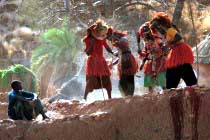 |
|
kundu
andou
|
|
yougo
dogorou
|
|
kundu
gina
|
|
The dancers pay
a last homage to the deceased and climb down the roof terrace. A close
parent, a son or brother, remains alone on the terrace, kneels down,
scratches the ground with his hands and throws earth over his shoulders.
He is looking for the Kine (a component of the soul) of the deceased
that is to return as the Nani (the respondent) in a newborn baby.
Meaning of the
Nani : The deceased choses among his descendents a respondent who when
grown up, will make sacrifices to his ancestor on the Wagem altar (Gorou
ritual - see page 15). The act of transmitting a part of one's soul
to a descendent, is a form of reincarnation.
|
 |
|
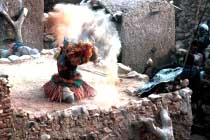 |
|
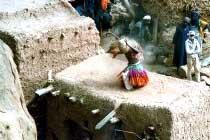 |
|
kundu
andou
|
|
kundu
andou
|
|
yougo
dogorou
|
|
In case the deceased
leaves behind a widow then the same ritual is performed differently.
For example, the masked dancer kneels down at the house's entrance and
pays his respects to the widow who at the same time is looking for her
late husband's Kine by means of a calabash that she is holding in her
hand.
|
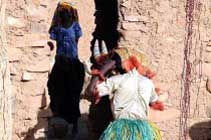 |
|
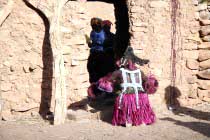 |
|
 |
|
kundu
andou
|
|
kundu
andou
|
|
kundu
andou
|
|
see :
- Polly
Richards " Imina Sana : (masques à la mode) - A study of Dogon Masquerade
at the Turn of the Millenium 1994-2000 page 149 "
- G.Dieterlen
" Les âmes des Dogons - pages 126/127 "
|
|
|